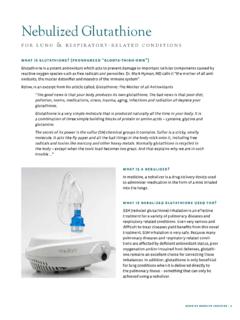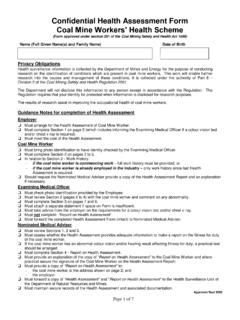Transcription of Spirometry Testing in Occupational Health Programs
1 Spirometry Testing in Occupational Health ProgramsBest Practices for Healthcare ProfessionalsOSHA 3637-03 2013 Occupational Safety and Health Act of 1970 To assure safe and healthful working conditions for working men and women; by authorizing enforcement of the standards developed under the Act; by assisting and encouraging the States in their efforts to assure safe and healthful working conditions; by providing for research, information, education, and training in the field of Occupational safety and Health . Material contained in this publication is in the public domain and may be reproduced, fully or partially, without permission. Source credit is requested but not information will be made available to sensory- impaired individuals upon request. Voice phone: (202) 693-1999; teletypewriter (TTY) number: 1-877-889-5627. This publication provides a general overview of a particular standards-related topic.
2 This publication does not alter or determine compliance responsibilities which are set forth in OSHA standards, and the Occupational Safety and Health Act. Moreover, because interpretations and enforcement policy may change over time, for additional guidance on OSHA compliance requirements, the reader should consult current administrative interpretations and decisions by the Occupational Safety and Health Review Commission and the would like to thank the American College of Occupational and Environmental Medicine (ACOEM) and Townsend Associates, LLC for their assistance in preparing this photo courtesy of Vitalograph. This image is for informational purposes only and does not represent an official OSHA endorsement of the products shown or their Testing in Occupational Health ProgramsBest Practices for Healthcare ProfessionalsOccupational Safety and Health Department of LaborOSHA 3637-03 2013 Occupational SAFETY AND Health ADMINISTRATIONivTABLE OF INTRODUCTION.
3 Spirometry OVERVIEW .. ACCURATELY MEASURING WORKER LUNG FUNCTION .. PERSONNEL INVOLVED IN Spirometry Testing .. EQUIPMENT .. CONDUCTING Spirometry TESTS .. INTERPRETING TEST RESULTS .. COMPARING WORKER RESULTS WITH THE NORMAL RANGE (REFERENCE VALUES) .. EVALUATING RESULTS OVER TIME .. QUALITY ASSURANCE (QA) REVIEWS .. Spirometry PROCEDURE MANUAL .. RECORDKEEPING .. REFERENCES ..38 APPENDIX A: NATIONAL Health AND NUTRITION EXAMINATION SURVEY III (NHANES III) REFERENCE VALUES ..40 APPENDIX B: CHECKLIST FOR Spirometry PROCEDURE MANUAL ..54 OSHA REGIONAL OFFICES ..56 HOW TO CONTACT OSHA ..57 Spirometry Testing IN Occupational Health INTRODUCTIONS pirometry, the most common type of pulmonary function test (PFT), is used to evaluate worker respiratory Health in medical surveillance Programs and to screen workers for their ability to perform certain tasks.
4 Spirometry results can play a central role in decisions about worker job assignments and personal protective equipment, and in the assessment of exposure-related Health effects. OSHA standards for asbestos, cadmium, coke oven emissions, and cotton dust require Spirometry Testing as part of medical surveillance (see 29 CFR , , , and ). OSHA standards for formaldehyde and benzene require pulmonary function Testing when respiratory protection is used at work (see 29 CFR and ).Whether Spirometry is conducted to comply with an OSHA regulation or as part of another workplace-mandated program, its value is compromised when Testing is conducted incorrectly, equipment is inaccurate, or results are misinterpreted. Technically flawed tests too often lead to inaccurate interpretations of worker respiratory Health , falsely labeling normal subjects as impaired or impaired subjects as normal.
5 Such flawed test results are not only useless but also convey false information which could be harmful to workers (1). Too often, those who conduct the tests or interpret the results are unaware of the impact of technical pitfalls and of current Spirometry Testing recommendations. Because Spirometry has become so important in Occupational Health practice, OSHA developed this guidance document to summarize what it regards as the elements of a good Occupational Health Spirometry program. Recommendations are based on current guidelines from the American Thoracic Society/European Respiratory Society (ATS/ERS), the American College of Occupational and Environmental Medicine (ACOEM), and the National Institute for Occupational Safety and Health (NIOSH) (2 8). OSHA s goal is to provide an update for the medical community on what are the required components for valid tests and strategies for interpreting results, so that Occupational Spirometry tests are useable and of high technical document provides a brief overview of the elements of Spirometry , followed by specific recommendations on: (1) accurate measurement of worker lung function (training of personnel, equipment considerations, and Spirometry test procedures); (2) appropriate interpretation of valid tests (comparing worker results with normal reference values and evaluating worker results over time); (3) Quality Assurance (QA) reviews; and (4) recordkeeping.
6 This document is organized to permit all readers, regardless of their level of Spirometry experience, to refer immediately to specific sections of OF THIS GUIDEThis guidance document is intended for medical personnel who oversee worker Health Programs , conduct Spirometry tests, and/or interpret Spirometry results. The goal of the document is to help ensure the collection of accurate, valid Spirometry results that are interpreted correctly. Such Spirometry assessments can be used to make well-informed decisions about worker respiratory Health (including the need for medical referrals), and to conduct Programs for prevention and early SAFETY AND Health Spirometry OVERVIEWSome respiratory diseases slow the speed of expired air; others reduce the volume of air that can be inspired and then exhaled. To detect these impairments, Spirometry measures the maximal volume and speed of air that is forcibly exhaled after taking a maximal inspiration.
7 Forced Vital Capacity (FVC) is defined as total exhaled volume after full inspiration. Speed of expired air is determined by dividing the volume of air exhaled in the first second, , the Forced Expiratory Volume in One Second (FEV1), by the total FVC to give the FEV1/FVC ratio. The time course of the expiration is recorded as a volume-time curve, and changes in expiratory flow rate are shown as a flow-volume curve (Figure 1). Measurements from a worker s valid Spirometry test are compared with a normal range ( , reference values) and/or with that worker s baseline test results to determine whether the measured volume and flow rate are significantly smaller or slower than expected. As described below, both the Spirometry test itself and the comparison of results with the normal range and/or baseline values should be performed carefully to guarantee an accurate interpretation of a worker s respiratory Health .
8 This document focuses first on accurately measuring worker lung function and second on appropriately interpreting test results. Recommendations are also made regarding QA review Programs and 1. Volume-time curve (left) and flow-volume curve (right). Reproduced with permission from ACOEM (5).6543210 FEV11234567891001234560121086420 Flow (L/s)Time (s)Volume (L)Volume (L)FVCFVCSPIROMETRY Testing IN Occupational Health ACCURATELY MEASURING WORKER LUNG FUNCTIONT hree factors work together to produce accurate, meaningful test results: (1) the technician should be well-trained, supervised, and skilled to coach the worker to record optimal test results; (2) the spirometer should be accurate; and (3) the worker should perform with maximal effort and cooperation. Failure of any one of these factors ( , the technician has poor coaching skills, equipment is inaccurate, or a worker does not perform maximal efforts) is likely to produce inaccurate results and lead to an incorrect assessment of respiratory Health .
9 PERSONNEL INVOLVED IN Spirometry TESTINGM edical personnel who conduct Spirometry tests and/or interpret the results should be able to identify technically flawed curves and distinguish valid from invalid tests. Commonly used spirometers generate printouts and reports, regardless of whether results are accurate. Simply reading a spirometer s interpretation is insufficient and can lead to serious misclassification of respiratory Health if tests are invalid. Training, knowledge, and understanding of Spirometry pitfalls are essential for all medical personnel involved in Occupational Spirometry Testing Spirometry tests are performed by healthcare personnel with varied backgrounds and credentials, ranging from physicians to medical assistants. Generally, the two types of personnel involved in Spirometry Testing and their responsibilities can be described as follows:(1) Physician or Other Licensed Health Care Professional (PLHCP).
10 In this document, the term PLHCP includes physicians, physician assistants, nurse practitioners, and in some workplaces, registered nurses. PLHCPs often oversee the Occupational Spirometry program, supervise technicians, clinically interpret Spirometry screening test results, and evaluate grouped Spirometry data for medical surveillance purposes. The PLHCP may be responsible for ensuring that technicians are well-trained and maintain their levels of competency, have the resources to do their job properly, and follow the clinic s Spirometry program guidelines. In some cases, the PLCHP may also conduct Spirometry tests. The PLHCP should be able to: (a) evaluate the technical quality and validity of Spirometry results before determining whether they indicate normal or impaired respiratory function; (b) communicate the meaning of the test results to the worker who was tested; and (c) evaluate test results for groups of workers at a workplace to determine if patterns of abnormal lung function might indicate a hazardous workplace exposure.












